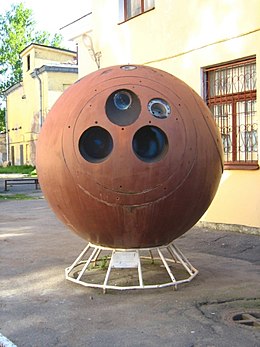 A Zenit reentry capsule | |
| Names | Zenit 2-36 |
|---|---|
| Mission type | Optical imaging reconnaissance |
| Operator | OKB-1 |
| COSPAR ID | 1966-021A |
| SATCAT no. | 2107 |
| Mission duration | 7 days, 19 hours and 3 minutes |
| Spacecraft properties | |
| Spacecraft type | Zenit-2 |
| Manufacturer | OKB-1 |
| Launch mass | 4730 kg[1] |
| Start of mission | |
| Launch date | 17 March 1966, 10:28:00 GMT |
| Rocket | Vostok-2 |
| Launch site | Plesetsk 41/1 |
| Contractor | OKB-1 |
| End of mission | |
| Disposal | Recovered |
| Landing date | 25 March 1966, 05:31 GMT |
| Orbital parameters | |
| Reference system | Geocentric[2] |
| Regime | Low Earth |
| Perigee altitude | 207 km |
| Apogee altitude | 545 km |
| Inclination | 72.0° |
| Period | 92.1 minutes |
| Epoch | 17 March 1966 |
Zenit programme Zenit-2 | |
Kosmos 112 (Russian: Космос 112 meaning Cosmos 112) or Zenit-2 No.36 was a Soviet, first generation, low resolution, optical film-return reconnaissance satellite launched in 1966. A Zenit-2 spacecraft, Kosmos 112 was the thirty-sixth of eighty-one such satellites to be launched[3][4] and had a mass of 4,730 kilograms (10,430 lb).[1] It was the first satellite to be launched from the Plesetsk Cosmodrome.[5]
Kosmos 112 was launched by a Vostok-2 rocket, serial number U15001-09,[6] flying from Site 41/1 at Plesetsk. The launch took place at 10:28 GMT on 17 March 1966,[7] and following its successful arrival in orbit the spacecraft received its Kosmos designation; along with the International Designator 1966-021A[1] and the Satellite Catalog Number 02107.[1]
Kosmos 112 was operated in a low Earth orbit, at an epoch of 17 March 1966, it had a perigee of 207 kilometres (129 mi), an apogee of 545 kilometres (339 mi), an inclination of 72.0° and an orbital period of 92.1 minutes.[2] After eight days in orbit, Kosmos 112 was deorbited, with its return capsule descending under parachute and landing at 05:31 GMT on 25 March 1966 et recovered by Soviet force.[5]
- ^ a b c d "Cosmos 112: Display 1966-021A". nssdc.gsfc.nasa.gov. NASA. 27 February 2020. Retrieved 29 March 2020.
 This article incorporates text from this source, which is in the public domain.
This article incorporates text from this source, which is in the public domain.
- ^ a b "Cosmos 112: Trajectory 1966-021A". nssdc.gsfc.nasa.gov. NASA. 27 February 2020. Retrieved 29 March 2020.
- ^ Krebs, Gunter. "Zenit-2 (11F61)". Gunter's Space Page. Archived from the original on 31 December 2011. Retrieved 3 January 2014.
- ^ Wade, Mark. "Zenit-2". Encyclopedia Astronautica. Archived from the original on 23 May 2012. Retrieved 3 January 2014.
- ^ a b Christie, Robert. "Zenit Satellites - Zenit-2 variant". Zarya.info. Retrieved 3 January 2014.
- ^ Wade, Mark. "Vostok 8A92". Encyclopedia Astronautica. Archived from the original on 22 August 2016. Retrieved 3 January 2014.
- ^ McDowell, Jonathan. "Launch Log". Jonathan's Space Page. Retrieved 3 January 2014.